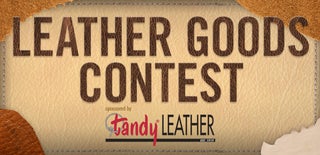Introduction: Leather Ski Gear
It may almost be summer down under, but that didn't stop me from preparing for my next big ski trip. In this Instructable i'll be taking you through the steps I took to create a leather ski mask and goggles.
Step 1: Leather Ski Mask
The first step is to make your leather ski mask
Step 2: Template Transfer
The first step is really to get an idea and draw it out. I freehanded the pattern (so I can't give you a file) and taped it together for test fits. After a bit of tweaking I drew up the flames and then photocopied the pattern. After finding a nice place to cut out the patterns I dampened the leather and replaced the original patterns with the photocopies. Next I used a standard ball point pen (you can use a tracing tool if you have one) to draw over all of the lines. You want to press down firmly with the pen so that you get nice lines but not too thick so you can make any changes you want with the swivel knife.
Step 3: Cutting Out the Template
Next I cut out the leather. There are hundreds of ways to cut leather a few being; with a razor, an exacto knife, fabric shears, leather shears, a rotary knife (for thinner leather), a head knife and the list goes on. Id recommend experimenting for a bit to see which method suits you. My preferred method is with scissors, I don't know what it is about knifes, but i can never seem to get a precise cut and I end up having to go back along cuts to get them right which leads to a choppy and dirty edge.
Step 4: Tooling (YAY!!)
For this particular project I only used a swivel knife and two stamps (a beveler and a backgrounding tool).
The first step is to go over your tracing with a swivel knife (remember to keep your leather damp). TIPS: A good technique a found to get even flames is to always start on one side of every flame and continue until you reach the tip of the last flame you carved, this ensures that all your flames look the same.
The next step is to bevel the flame. I can't believe I'm saying this but remember to bevel the flame so it pops out! the last thing you want is to make your flame recede (although this can work in some cases)
The final step with tooling is to background the piece. I Just went around the edges of each flame, the tooling getting thinner toward the top. TIPS: Keep you bevel stamp flat so that you don't get "Toes" everywhere (although again this could work depending on what you want your finished piece to look like). My next tip is to not keep it to geometrical, move the tool around a bit because geometric backgrounding will show up in the finished piece (once again, this technique can work to your advantage depending on what you want).
Step 5: Preparing Eyelets/Grommets
The next step is to prepare your eyelets/grommets (the correct term depends whether your fancy or not). I wanted to add a bit of colour to my eyelets so i tempered/heat anodised them (don't know what the correct term would be =/ ). To do this i just heated them up with a cooking blow torch because it was a bit softer on the heat and i could control it easier. In the third photo i show a variety of colours you can get with this technique depending on the heat you give (not heated on the left to overly heated on the right). I then marked out where i wanted the breathing holes and punched them out.
Step 6: Bevel the Edges of the Leather
The next step was to bevel the edges of the leather where the two pieces would meet. This ensures a clean seam line. To do this i used a sharp xacto knife.
Step 7: Wet Forming
IMPORTANT: I mucked up here and started finishing the leather before i wet formed the leather. This just meant that the leather was harder to wet and harder to dry (as water can only enter and escape through the back).
The process of wet forming is fairly simple. I soaked the leather in hot water (just enough to cover the leather). The water should be hot but just cool enough to be able to withstand the temperature with your bare hands. Some people like their water hotter, others cooler. Personally i prefer slightly cooler water (because i didn't have to form it much and its easier to work with). The leather is soaked for 10-15 minutes or until the leather stops bubbling.I then made the leather into a rough shape and layer it in the sun (YAY SUMMER). I sat by it to make sure it didn't deform and also hand shaped the spikes just a bit.
Other wet forming techniques include using an oven or using moulds but this worked fine for my (seeing as Australia practically is an oven)
Step 8: Finishing and Staining the Leather (The Long Step =/ )
This is one of the most extensive steps in this project and i put quite a bit of work into finishing this piece. My end process was:
1: Lacquer
2: Dye
3: Realise you f*cked up and wet form the leather now instead of two steps ago
4: Dye (again but just highlights)
5: Lacquer (again)
6: Apply finish
7: Buff
To laquer i used "Neat-lac" but i understand that this is now out of production. You can get clear lac or wyo sheen now instead. To apply it i used an old tshirt and rubbed it on in a circular motion.
To dye the leather i used a thin artist brush and carefully dyed around the flame dying down toward the edges (just as i did the backgrounding). I then applied a light wash around everywhere else (besides the flame)
To finish the leather i used "Leather dew" from my local shoe shop (because i didn't want to drive an hour to Tandy's, sorry =P ) which apparently cleans, softens and protects leather. I did this step after lacing so don't be confused by the photos.
I then buffed the leather with some sheep wool.
Step 9: Inserting Eyelets/grommets
To insert the eyelets just follow the directions on the packet. Notice that a dyed the area around the holes to add a weathered finish.
Step 10: Lacing
The first step to lacing is to mark out and punch the holes. I didn't have a punch so i used a drill. A lot of people will tell you that drilling holes is dirty and trust me... It is. If i were you, I'd do myself a favour and buy a punch.
I then did a simple lace (I thought it would fit better than a Mexican round or double loop) Im not going to go into detail about stitching because there are hundreds of tutorials online and i probably didn't do anything right anyway.
Step 11: BEESWAX
To protect my nose and mouth from the "knots" caused by lacing, i pile up a liberal amount of beeswax in those areas with "knots" and shaped them.
Step 12: Straps
The straps for this piece were quite troublesome. First i took an old watch strap and cut it where i felt necessary). and punched holes in the strap and mask. Then rivet the straps to your piece. PLEASE MEASURE BEFORE YOU ATTACH THE STRAPS!!! I ended up having to remove one set of rivets to make the strap shorter and then then both of them to lower the angle of the straps so the mask would hug my face.
Step 13: Leather Goggles
Step 14: Template and Cutting
Once again, I freehanded a pattern based on my ski goggles. My pattern was four parts (top, bottom and two sides). If you were less stingy with your leather you could probably make do with one piece of leather. I also drew up a few flames for the side pieces and traced them on as well. I managed to get my two side pieces out of a piece of scrap.
Step 15: Tooling (again =3 )
To tool these pieces, I used the exact same process as when i tooled the mask.
The first step was to use the swivel knife to carve out the flames
Next I beveled the flames (just as I did before)
The final step was to background the flame
Step 16: Wet Forming
This time I wet formed the leather at the right time so it was slightly easier. Again i used the exact same process as i did before.
Soak the pieces in hot/warm water for 10-15 minutes (or until the leather stops bubbling plus a few minutes for safe measure). Then I form the leather to the goggles and lay the leather in the sun checking every 5-10 minutes.
Step 17: Finishing
My process for finishing the goggles after wet forming was:
Lacquer
Dye
Lacquer
Once again, just follow the steps outlined before
Step 18: Stitching
I am so, so bad at stitching so I'm not even going to try explain my method. If you do search for hand stitching leather you are bound to find a way that you like. I just used two needles and thick denim thread. One thing i would do differently next time is to use thread that is lighter than my leather to make it stand out.
Tips: My biggest tip is to be consistent, no matter how you do your first stitch, do it like that for the rest of them even if its wrong.
Step 19: Attaching to the Goggles
The next step was to attach the leather to the goggles. to do this, I simply ran more thread through the stitching holes then knotted them to the goggles. There are plenty of better ways (and plenty worse) but i chose the way that i did because i thought i was simple but still strong enough to hold the leather.
Step 20: Finished!!!

Participated in the
Wear It! Contest

Participated in the
Leather Goods Contest













